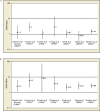Hormonal contraceptive options for women with headache: a review of the evidence
- PMID: 20842283
- PMCID: PMC2938905
Hormonal contraceptive options for women with headache: a review of the evidence
Abstract
Migraine affects as many as 37% of reproductive-age women in the United States. Hormonal contraception is the most frequently used form of birth control during the reproductive years, and given the significant proportion of reproductive-age women affected by migraine, there are several clinical considerations that arise when considering hormonal contraceptives in this population. In this review, key differences among headache, migraine, and migraine with aura, as well as strict diagnostic criteria, are described. The recommendations of the World Health Organization and the American College of Obstetricians and Gynecologists regarding hormonal contraception initiation and continuation in women with these diagnoses are emphasized. Finally, information about the effect of hormonal fluctuations on headache is provided with recommendations regarding contraception counseling in patients who experience headache while taking hormonal contraception.
Keywords: Estrogen; Hormonal contraceptives; Migraine with aura; Migraine without aura; Progesterone; Stroke.
Figures
Similar articles
-
Use of combined hormonal contraceptives among women with migraines and risk of ischemic stroke.Am J Obstet Gynecol. 2017 May;216(5):489.e1-489.e7. doi: 10.1016/j.ajog.2016.12.019. Epub 2016 Dec 26. Am J Obstet Gynecol. 2017. PMID: 28034652 Free PMC article.
-
Combined hormonal contraception use in reproductive-age women with contraindications to estrogen use.Am J Obstet Gynecol. 2016 Sep;215(3):330.e1-7. doi: 10.1016/j.ajog.2016.03.047. Epub 2016 Apr 5. Am J Obstet Gynecol. 2016. PMID: 27059507 Free PMC article.
-
Hormonal contraceptives and risk of ischemic stroke in women with migraine: a consensus statement from the European Headache Federation (EHF) and the European Society of Contraception and Reproductive Health (ESC).J Headache Pain. 2017 Oct 30;18(1):108. doi: 10.1186/s10194-017-0815-1. J Headache Pain. 2017. PMID: 29086160 Free PMC article.
-
Contraception and headache.Headache. 2013 Feb;53(2):247-76. doi: 10.1111/head.12035. Headache. 2013. PMID: 23432442 Review.
-
[Migraine and contraception].Gynecol Obstet Fertil. 2015 Mar;43(3):234-41. doi: 10.1016/j.gyobfe.2015.01.006. Epub 2015 Feb 27. Gynecol Obstet Fertil. 2015. PMID: 25727163 Review. French.
Cited by
-
Postoperative pain, nausea and vomiting among pre- and postmenopausal women undergoing cystocele and rectocele repair surgery.Korean J Anesthesiol. 2015 Dec;68(6):581-5. doi: 10.4097/kjae.2015.68.6.581. Epub 2015 Nov 25. Korean J Anesthesiol. 2015. PMID: 26634082 Free PMC article.
-
Mal de Debarquement Syndrome: A Retrospective Online Questionnaire on the Influences of Gonadal Hormones in Relation to Onset and Symptom Fluctuation.Front Neurol. 2018 May 24;9:362. doi: 10.3389/fneur.2018.00362. eCollection 2018. Front Neurol. 2018. PMID: 29910765 Free PMC article.
-
Oral contraceptive misuse as a risk factor for cerebral venous and sinus thrombosis.J Res Med Sci. 2012 Apr;17(4):344-7. J Res Med Sci. 2012. PMID: 23267395 Free PMC article.
-
Headache for ophthalmologists: current advances in headache understanding and management.Eye (Lond). 2021 Jun;35(6):1574-1586. doi: 10.1038/s41433-021-01421-4. Epub 2021 Feb 12. Eye (Lond). 2021. PMID: 33580185 Free PMC article. Review.
-
Oral contraception following abortion: A systematic review and meta-analysis.Medicine (Baltimore). 2016 Jul;95(27):e3825. doi: 10.1097/MD.0000000000003825. Medicine (Baltimore). 2016. PMID: 27399060 Free PMC article.
References
-
- Stewart WF, Wood C, Reed ML, et al. Cumulative lifetime migraine incidence in women and men. Cephalalgia. 2008;28:1170–1178. - PubMed
-
- Finer LB, Frohwirth LF, Dauphinee LA, et al. Reasons U.S. women have abortions: quantitative and qualitative perspectives. Perspect Sex Reprod Health. 2005;37:110–118. - PubMed
-
- Rosenberg MJ, Waugh MS. Oral contraceptive discontinuation: a prospective evaluation of frequency and reasons. Am J Obstet Gynecol. 1998;179:577–582. - PubMed
-
- Rosenberg MJ, Waugh MS, Long S. Unintended pregnancies and use, misuse and discontinuation of oral contraceptives. J Reprod Med. 1995;40:355–360. - PubMed
-
- Lipton RB, Bigal ME, Diamond M, et al. Migraine prevalence, disease burden, and the need for preventive therapy. Neurology. 2007;68:343–349. - PubMed
LinkOut - more resources
Full Text Sources
Miscellaneous


